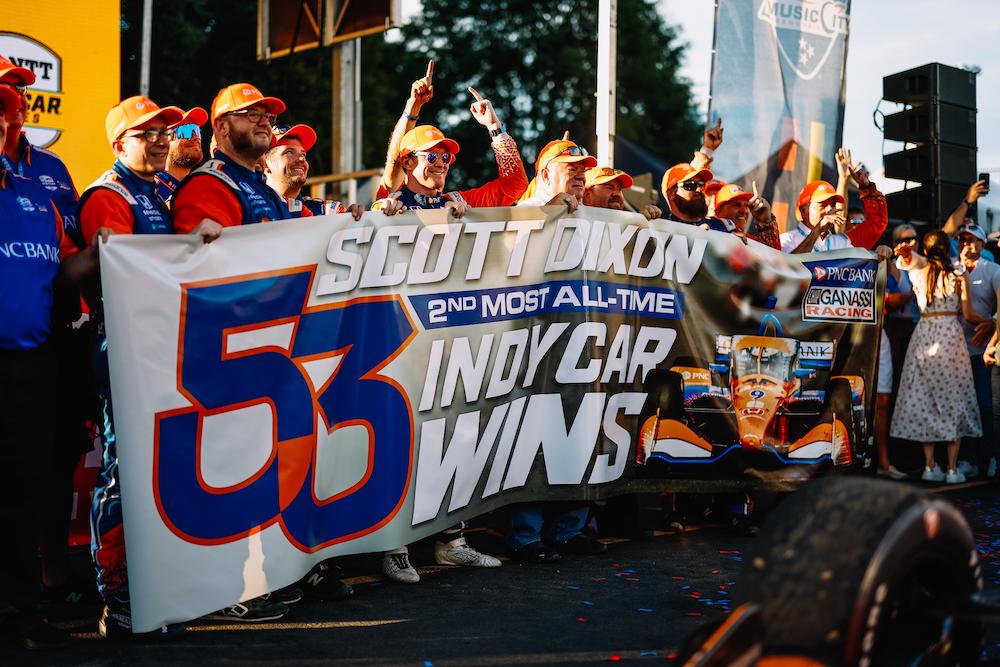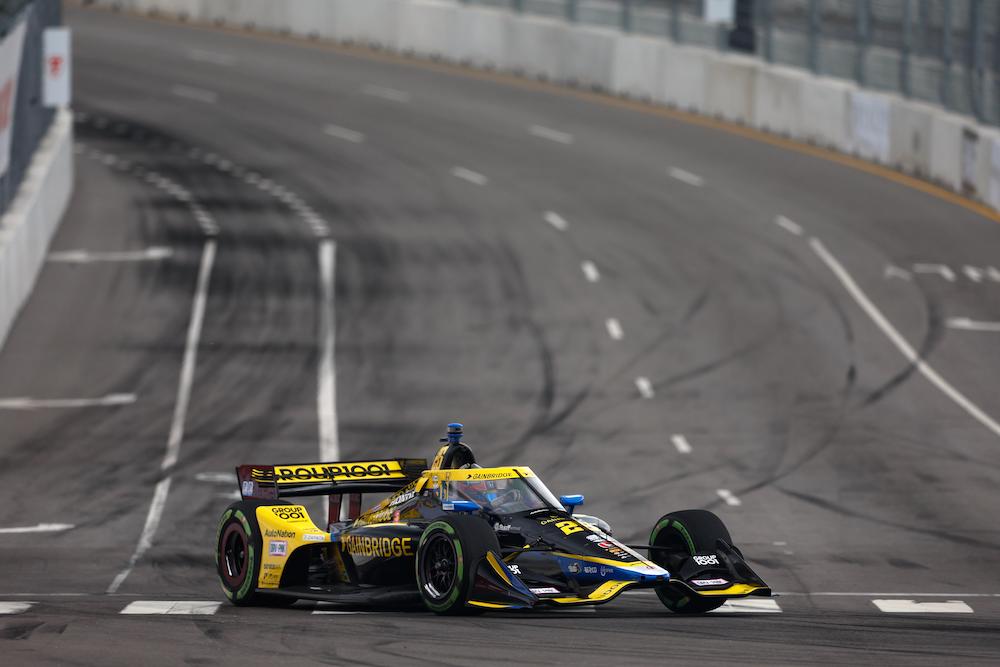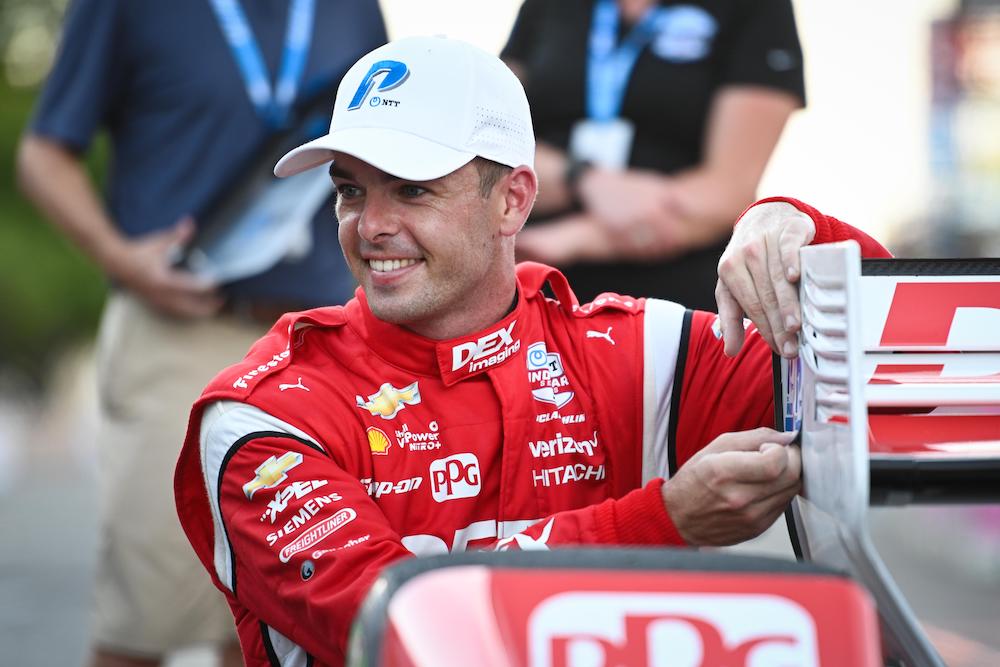What: Big Machine Music City Grand Prix / Race 13 of the 2023 NTT IndyCar Series
Where: Nashville, Tenn. — 11-turn, 2.1-mile temporary street course
When: Sunday, Aug. 6, noon ET (green flag 12:30pm ET)
When it comes to the NTT IndyCar Series, there’s a well-proven mantra: “It’s IndyCar — anything could happen.” And that’s never truer than in the Big Machine Music City Grand Prix.
In IndyCar, the margins between triumph and disaster, confidence and confusion, and winning and losing, are fine ones, but they’re seldom finer than on a weekend in downtown Nashville, Tennessee.
The 2.1-mile street course that zips past the Nissan Stadium, home of the Tennessee Titans NFL team, and crosses the Cumberland River via the Korean War Veterans Memorial Bridge, is one of the most distinctive race tracks in the world, and the first two IndyCar races there have been suitably memorable.
The first, in 2021, saw Chip Ganassi Racing’s Marcus Ericsson caught up in an accident in the opening laps — one violent enough to lift his nose almost to the vertical after running into the rear of Sebastien Bourdais’ AJ Foyt Racing machine. But after limping to the pits for makeshift repairs, then suffering a drive-through penalty, and spending the remainder of the race with askew steering and bent suspension, the Swede came home the winner.
Remarkably, another Ganassi driver, ageless master Scott Dixon, won last year’s Nashville race (below) after suffering early damage and dropping way down the order. He shrugged off the seemingly debilitating effects of major damage to his car’s floor and multiple early pit stops to run a very long final stint. Despite extremely worn tires, he survived a late-race restart to hold off fellow Kiwi and polesitter Scott McLaughlin of Team Penske on the run to the checkered flag and his 53rd career IndyCar win.
Can the third Music City GP produce similar drama this weekend? You better believe it. It’s as if track designer Tony Cotman of NZR Consulting devised the layout in the heart of country music land to throw as many challenges as possible at the drivers, engineers, engine manufacturers and tire supplier Firestone.
Damper setup is key as the cars pitter-patter over the bumps in the braking zones, and the differentials need to help a driver rotate the car on turn-in, yet be forgiving enough to help settle it and allow the outside rear to dig in rather than spin away its 750hp-plus. The Firestones are worked hard too, the green, guayule-infused sidewalls of the alternate compound and the black “primaries” providing enough stiffness to maximize the footprint, but enough flexibility to work with the suspension and grip the pavement even when lightly loaded or on off camber turns.
The engines, too, must provide enough lowdown torque to push the cars hard out of the tight corners, yet the power must arrive progressively enough not to leave the rear tires scrabbling for grip and burning off their shoulders. The long “straight” of the gently curving bridge, particularly on the return leg from Turn 8 to Turn 9, sees the engine working hardest, from a slow (greater than 90-degree) right-hander taken at 47mph onto a flat-out blast that sees the cars reach 177mph
The back-and-forth blasts across the bridge are so key to the lap that, however tempting, engineers and drivers won’t dare to load up the cars with downforce for the tight, tricky, weaving run between the buildings on the remainder of the track. That means the drivers must live with their cars running loose, and must judge how much speed they can take into the turns to leave enough space to catch the tail on exit. It’s a quite mesmerizing sight in qualifying, and adds to the drama on race day as the drivers seek alternate lines to catch the car in front or hold up the one behind.
There’s another mantra in IndyCar, and it’s that “cautions breed cautions.” Again, Nashville’s the poster child for that one. The tight track and the “Hail Mary” nature of some of the passing attempts mean an incident is never too far away. In 2021, nine cautions accounted for 33 of the 80 race laps, and despite a growing familiarity with the track and its challenges, eight cautions ate up 36 laps last year. If it’s more of the same this time around, race strategies can change with every full-course yellow, but it’s also a chance to shine for the brain trusts calling the plays on the pit stands and their abilities to react, improvise and second guess.
You can follow the action on Peacock — practice on Friday, August 4, practice (x 2) and qualifying on Saturday, Aug. 5, while NBC (and Peacock) will provide the race day action. And to get even closer to it all, grab the best seat in the house with the INDYCAR App powered by NTT DATA and its 14 race day live onboard cameras.
TUNE IN
Friday, August 4 / 4:00pm – 5:15pm ET – Practice 1 – Peacock
Saturday, August 5 / 11:40am – 12.40pm ET – Practice 2 – Peacock
Saturday, August 5/ 2:45pm – 4:15pm ET – Qualifying – Peacock
Saturday, August 5 / 6:25pm – 6:55pm ET – Practice 3 – Peacock
Sunday, August 6 / Noon – 3:00pm ET – RACE – NBC
• All sessions and the race are also available as audio commentary on SiriusXM and INDYCAR Radio.
Ride along with the INDYCAR App powered by NTT DATA
Taking you inside the action, 14 drivers will be carrying in-car cameras. During the race, you can live-stream every one of them with the INDYCAR App powered by NTT DATA. You choose who you ride along with, and you can switch drivers at any time. The App’s free to download for fans worldwide and you can find out more HERE. If you’re not already onboard, take your viewing experience to a whole new level HERE
Bringing you the onboard action from the Big Machine Music City Grand Prix are…
Josef Newgarden / No. 2 Team Penske Chevrolet
His pair of wins at Iowa Speedway (below) have helped two-time IndyCar champion Newgarden trim the gap a little to runaway 2023 points leader Alex Palou — the Chip Ganassi man who beat him to the 2021 title. But the canny Spaniard’s podium finish in the second race in Iowa still leaves the Penske driver with an 80-point gulf to traverse, despite now matching Palou’s victory tally of four. Although this is his home race, Nashville has not yet been a happy hunting ground for Newgarden, who finished only 10th and sixth in the first two editions of the Grand Prix here. That form must improve for any chance to catch Palou in the points with only five races to go.
Pato O’Ward / No. 5 Arrow McLaren Chevrolet
O’Ward is a threat on any type of track — his fast hands and deft feet can make a car dance like Fred Astaire. However, with the exception of the new track in downtown Detroit, the Arrow McLarens haven’t looked quite on par with the best of the opposition on bumpy street courses in 2023. On the basis of his lost victory in the season opener at St. Petersburg, when O’Ward was clearly punching above his weight until stymied by a transient engine issue, it’s fair to say a temporary track owes him.





